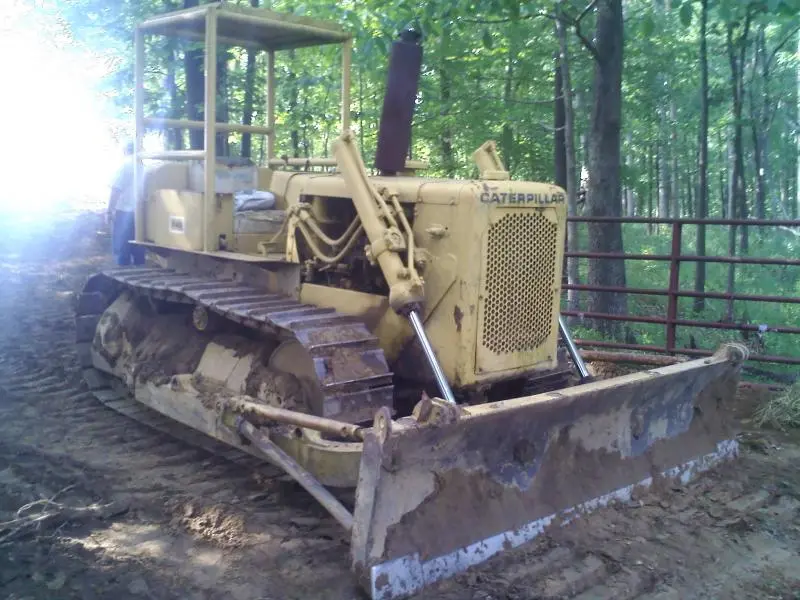
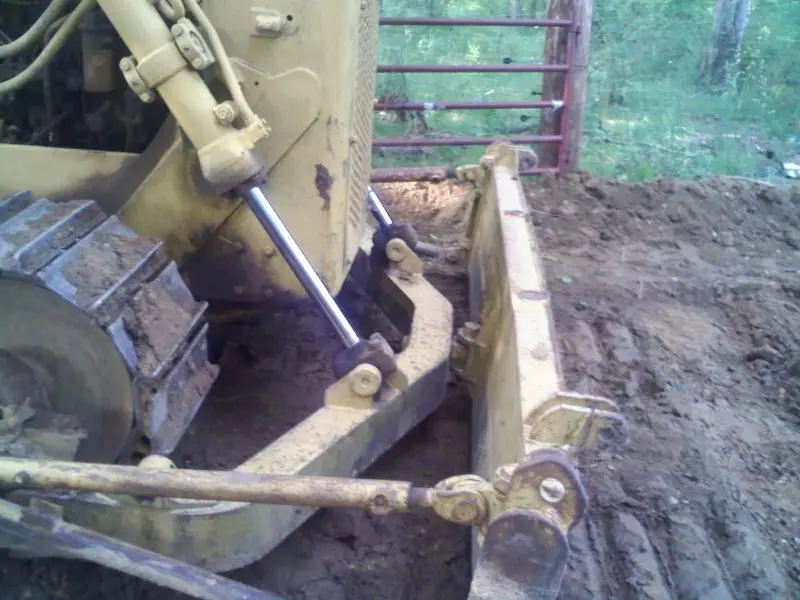
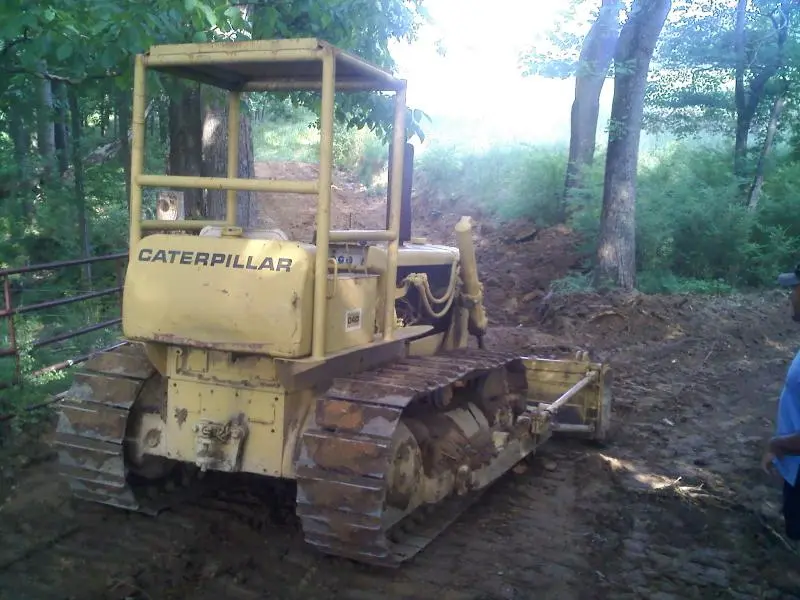
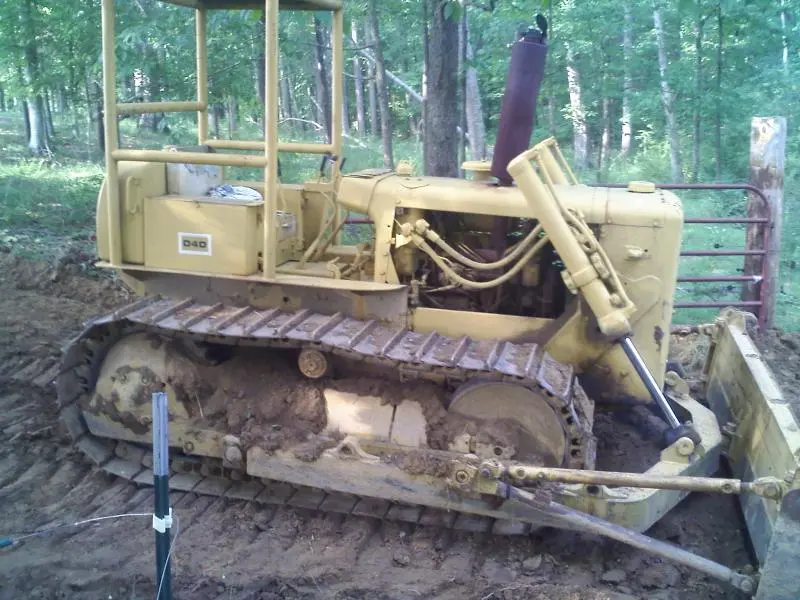
If you have a decelerator pedal, that works like you describe, you're dealing with a power shift transmission with a torque converter drive from the engine.
Your cousin's advice is good for a manual transmission and clutch drive.
You should be able to slow the machine with the brakes anytime you want as long as the engine is idling. (or even if it's not, but the brakes won't do much good trying to overpower the engine). The brakes are making the torque converter slip instead of windmilling along with the idling engine. Once you rev up the engine, the torque converter gets a lot more powerful and the brakes would have a lot harder time slowing the tractor down.
You could always select a lower gear instead of backing down the hill in the same high gear if you want to save the brakes.
As for spinning the tractor, unless you release a steering clutch, even applying one brake alone won't spin anything unless you have a pedal steering type machine. When going forward sometime, apply one brake and see what happens. If nothing much, you don't have pedal steering where the pedal first disengages the steering clutch on that side and then when pressed further, applies the brake on that side alone.
You have a wonderful day. Best wishes. Deas Plant.
Hi, KeveW.
One question comes to mind here. Exactly how much seat time does your cousin have on clutch-and-brake steered crawlers? The brakes are there to act as brakes and may be used with or without a steering clutch disengaged, depending on the circumstances and need.
CCjersey has it pretty right. Unless you disengage a steering clutch, either brake pedal will work equally well (assuming similar adjustment and condition) on both tracks 'cos there is NO differential in that jigger, just a 'solid' shaft with a clutch on either end to allow you to disconnect power to one track or the other to turn. There is NO reason why you can't use the brakes, one at a time or both together, to slow you down if need be (Again, assuming there is nothing wrong with either brake.
There is how-wevver, another wrinkle to this story. If you are going downhill, either forward or backward, and the load or the weight of the tractor is pushing the engine, you can do what is commonly called 'cross-steering' - disengage the steering clutch on the side you want to turn AWAY from and that side will usually go faster, turning you towards the other side where the clutch is still engaged.
This practice is not recommended for really steep country or if you are in a runaway situation. If you are going to try it, practice it on some lesser slopes and get used to the idea and the sensation of it before trying it on steeper ones.
Happy downhilling.
ok, let me try to answer some of this. lol my d4d has two brake pedals, and two steering cutch levers coming up out of the floor. the shifter is on the left in front of the left batt. box next to the seat. i'll get a cab pic today and post it. It also has two decel pedals that are connected to each other. My cousin has owned 3 or 4 dozers in the last 15 years, He also owns a track loader, trackhoe, road grader and bobcat. I may have confused some of what he said, but from what I remember, he said steer with the steering clutches if possible but if it won't turn as much as I want, then pull the steering lever first, then press the brake pedal on the same side to turn it. He also said try to press it gradually instead of all at once as to not jerk it around. He said jerking it is bad on the brakes etc. I've watched him build some pretty big ponds. Looks like he knows his stuff as best as I can tell. He also does all of his own mechanical work on all of his stuff. He knows what he's doing mechanically I know. I think I've got the jest of it better now. I think he said I could use the brakes without clutching first, just that it's not good for it. He was telling me so much that I got it all jumbled up a little. I know he was showing me on his how the brake pedals disengage the clutch first then brake, unlike mine which are seperate. He said one of his previous ones was like mine. I think his is a Komatsu but i'm not sure. He said it's the size of a d8 when I asked. My problem with going backwards downhill. I've only done this on some slight grades, and it was the first couple times I was even on my dozer after I bought it. Never been on one before. It wasn't anything dangerous. I just kept getting confused as to what to do to stop it if I needed to. lol I've got a better idea now after playing on it some more and actually understanding what was going on mechanically. I made him explain the mechanics of it. When I got on it the first few times I thought the steering levers were actually just applying the brake lightly. Didn't know they were disengaging the clutches. I now know better. Thanks for the info guys. I'm gonna change my oil and filter today and lube all the grease fittings and try to check some of the other filters on it. It has rained a good bit this week so I may not get to practice with it any. I have a new question though. The bits on my blade are dull, can I have these sharpened? Oh, and the filter thing on top of the hood is missing. The cover piece and the wing nut is there, just not the filter trap thing itself. Do I need to get this from cat or can I use an aftermarket? I haven't ran it in anything dusty yet.
You have a wonderful day. Best wishes. Deas Plant.
Hi, KeveW.
GET THE FILTER BOWL. That arrangement is actually a pre-cleaner that takes a lot of the dust out of the air by centrifugal action but it doesn't work without the see-through plastic bowl. The whole arrangement is possibly made by Donaldson. If so, you could get a new bowl through any Donaldson outlet. I don't know who that might be in your area as I am from DowNunder. I would guess that a lot of different machinery dealers would be able to help you out as Donaldson air cleaners appear on a lot of different makes and models. If you don't have the part number, just take the top in with you so that they can get an idea of the size.
It's not terrribly important who the bowl is made by, only that it is there, that it is complete and un-cracked and that it fits properly.
As CR mentioned in his post above, some crawlers - mostly track loaders - are pedal steering. With this arrangement, the first few inches of pedal travel disengages the steering clutch while the rest of the travel applies the brake. Standing on one of those pedals while travelling downhill can most definitely cause you to suddenly slew sideways. Most machines with this system also have a third pedal in the middle which applies BOTH brakes simultaneously.
Your D4D does not have that steering system if you have two levers as well as the two pedals. If your cousin was demonstrating steering technique on a machine with pedal steering, it is no huge wonder that you were confused. You are not going to do your brakes much harm by using them as brakes without disengaging the steering clutches first. Cat had been making crawlers for a little while by the time your D4D was built and I faintly suspect that they had learned to take such things into account when designing and building a crawler. Besides, how else are you going to stop the jigger?
What you have there is a machine with a powershift transmission. There is a torque converter between the engine and the transmission. The transmission has five clutch packs, one each for forward and reverse and one for each speed. When selecting a gear, you select the direction and one gear clutch pack and the transmission engages them for you. Cat powershift transmissions usually have a planetary gear set immediately behind the engine that splits the engine power and delivers about 30% direct to the transmission andthe remaining 70% to the transmission through the torque converter. This system is what gives you the feeling of immediately having power to the tracks without there being much shock load. How-wevver, it does slightly reduce the engine's ability to brake the machine,so you would need to use the brakes a little more than if your machine was a direct drive machine.
Hope this helps.
That does clear things up some more Deas plant. Every little bit helps. I haven't been on it in a couple weeks but I don't think it'll turn hardly any if I don't pull the steering clutch first. I'll have to check that out and make sure. Could be something out of adjustment maybe?
You have a wonderful day. Best wishes. Deas Plant.
Hi, KeveW.
If you have clutch-and-brake steering - which it appears you do - and you stand on a brake without that steering lever pulled back and the tractor turns, Houston, you have a problem. What that would mean is that steering clutch is either slippping sadly or not engaging at all. The tractor is NOT supposed to turn at all unless one steering clutch IS disengaged. A load pulling offset or travelling across a side slope may make the tractor veer off course but that has to do with outside influences affecting the tractor, not steering issues.
The basic rule might go something like this. Use the brakes any old time you want to slow down when going downhill to prevent engine overspeed or achiev better control. Use the brakes in conjunction with placing the powershift control in neutral if you want to stop. If you want to turn, disengage the steering clutch on the side you want to turn to BEFORE applying the brake.
Now may I suggest that you get out there and do some practice laps before you forget it all - and have some fun as well.
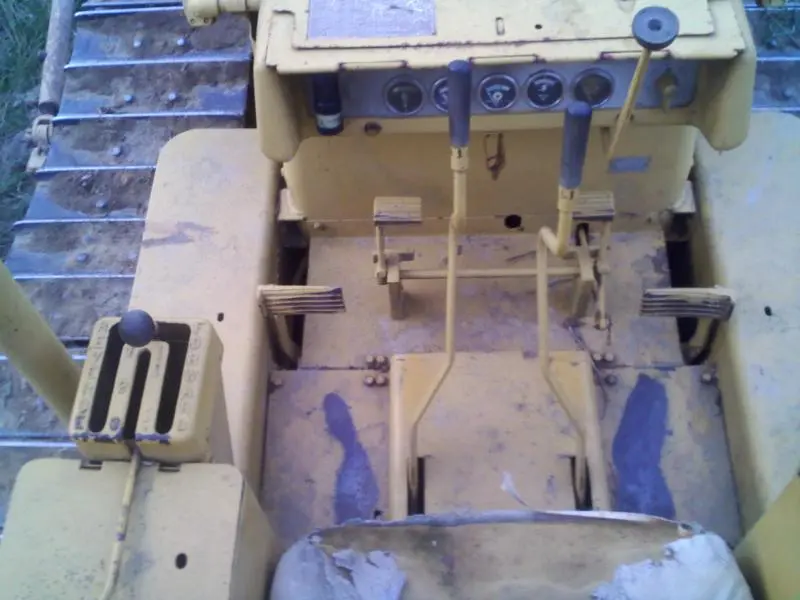
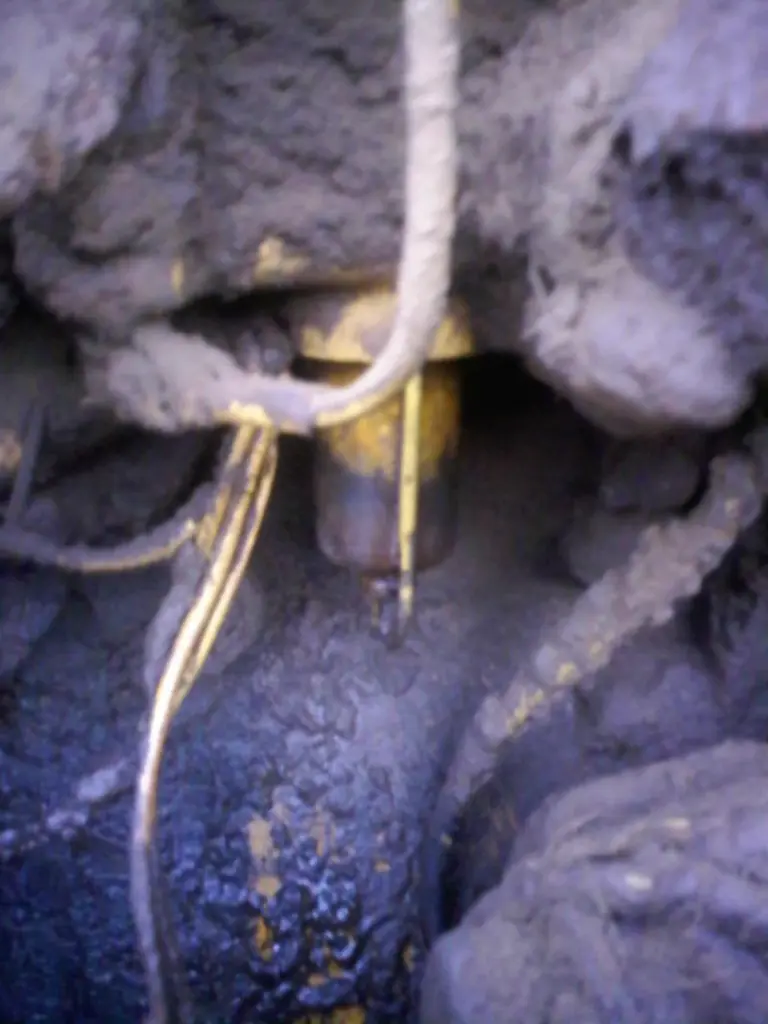
ok i was finally on the dozer again today. it won't turn with either the right or left brake pedal alone. I have to pull the left steering clutch then hit the left pedal, or vice versa. the steering clutch lever alone will turn it slightly but not much w/0 also hitting the pedal for that side. seems like the steering/clutch lever would completely disengage the clutch for that side and allow it to turn more.....maybe they need adjusting? The steering clutch levers do allow it to turn a good bit more without the brake pedal when pushing dirt. I greased some of the fittings but have two that wouldnt take any grease. guess I need to change those two fittings out with new ones. I'm gonna try to find the oil filter cartridge, fuel filter, at NAPA tomorrow. I need to find the plastic see through pre filter somewhere too. Also, the other day I turned the fuel shutoff valve off and then back on and it has been seeping some fuel since where the fitting screws into the bottom of the tank. When i try to tighten it up, it'll move easily either way but the steel fuel line wont let it turn much. My cousin said it should have a rubber grommet in the bottom of the tank probably. Is that the case and where can I get one if so? Also can somebody explain how the bowl fuel filter on the side of the engine seals off? it is leaking a good bit and needs fixing bad. i've lost about 10-15 gallons in the last couple of weeks with it just sitting. here are pics of the cab setup and the fuel bowl on the engine that is leaking so bad. where can i get a gasket or o-ring for that?
You have a wonderful day. Best wishes. Deas Plant.
Hi, KeveW.
The behaviour that you describe from your steering clutches is about what I would expect from normal, well-adjusted steering clutches. Just like 'normal(?), 'well-adjusted' humans, they don't change their course much unless sumpin makes 'em. In the tractor's case, that easy. Either brakes or load. With humans -- agh, let's not go there.
Let's look at it thisaway. You have two tracks, each with about 6 feet of track on the ground, complete with grousers buried in the dirt, and both being driven together. Suddenly, some heavy-fisted clown comes along and pulls a lever which disconnects the power from one of those tracks but does nothing else to impede that track, stop it or slow it down. Do you think that that track is going to be easily moved away from its present line of travel without some further persuasion, especially considering that it has those grousers buried in the ground as well? It is more likely to just keep rollin' along - like Ol' Man River.
Now if you put some sort of load behind those two tracks so that it is shared pretty evenly by both tracks, gett'em rolling again and pull one of those levers, you are highly likely to get a different reaction - - because the load will help to hold the unpowered track back, allowing the one still being driven to pull ahead.
So, I'd suggest that you keepya grubby mitts off the adjustments for the moment.
If my memory serves me right, that filter bowl ought to have cork gasket or seal at the top of it. Inside, there may be a segmented screen consisting of almost the same number of segments as America's debt in dollars, all fitted over a center bolt of almost miniscule proportions. Said bolt screws up into the housing to which the fliter bowl clamps. This bolt with its filter segmenst ought to be taken out and washed every once in a while. Try not to lose the segments off the bolt or you may feel you're playing 52 Pick-up again.
That leak around the cock in the bottom of the tank can probably be cured by emptying the tank, removing the pipe from the cock, removing the cock, putting a generous wrapping of teflon thread tape around the stem of the cock and re-fitting everything. Be careful not to get any tape over the in-tank end of
the cock.
Hope this helps.